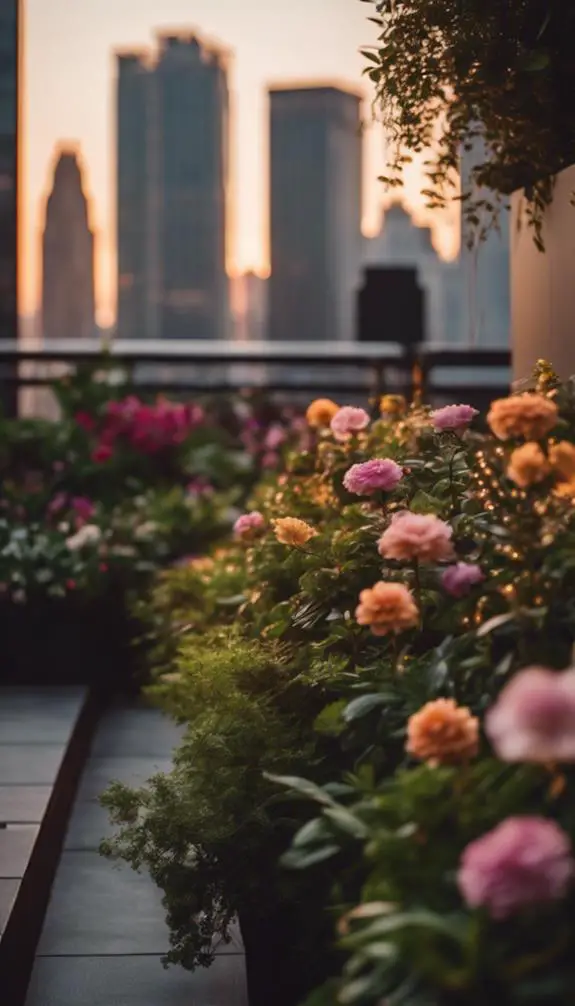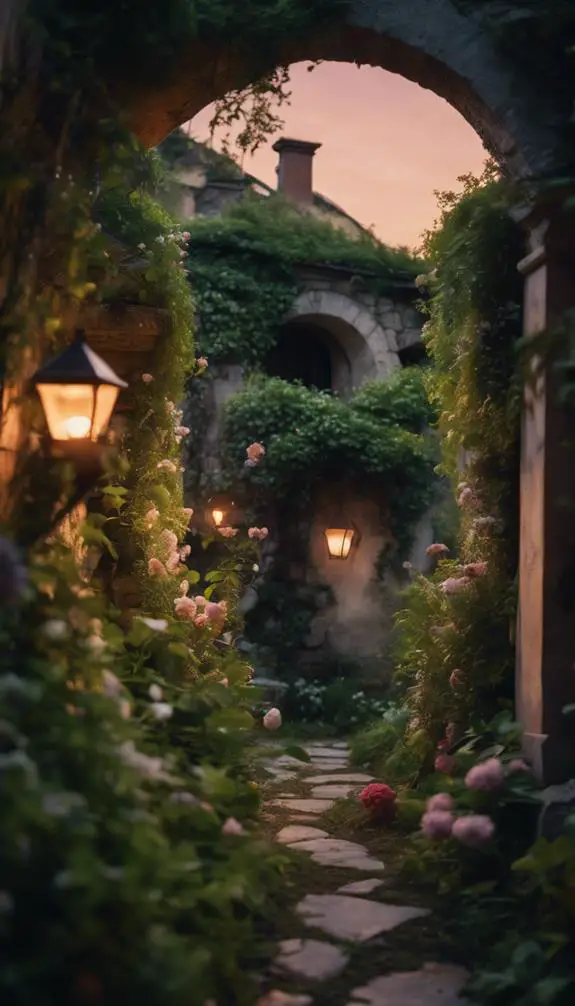As you step into your shade garden, you're surrounded by the soothing ambiance of nature. But, do you know how to tap its full potential? By understanding the intricacies of shade garden design, you can transform this tranquil space into a stunning retreat. From selecting the right shade-loving plants to incorporating clever lighting and focal points, the possibilities are endless. And, with the right strategies, you can create a haven that not only calms the senses but also showcases your personal style. So, what's the first step in bringing your shade garden vision to life?
Summary
- Evaluate site conditions to dictate plant choices and overall aesthetic, considering sunlight, soil, moisture, and wind direction.
- Create shade layers from densest canopy to lightest undergrowth, and consider garden themes like woodland oasis or modern retreat.
- Select plants adapted to low-light conditions, group by light requirements, and use layered planting strategies for visual interest.
- Incorporate lighting that illuminates the area and creates visual interest, using solar lanterns, string lights, or LED lights to highlight features.
- Combine plants with varying textures, colors, and patterns to create visual interest, and consider vertical gardening and water features for added depth.
Shade Garden Design Essentials

You start designing a shade garden by evaluating the site's conditions, which will dictate the types of plants you can use and the overall aesthetic.
Assess the amount of sunlight the area receives, as well as the soil type, moisture levels, and wind direction. This information will help you create shade layers, from the densest canopy to the lightest undergrowth.
Next, consider the garden themes you want to incorporate, such as a woodland oasis or a modern retreat.
Visualize the space and how you'll use it, taking into account the flow of traffic and the placement of seating areas or water features. By carefully evaluating these elements, you'll create a cohesive and functional shade garden that's tailored to your unique needs and style.
Choosing the Right Shade Plants
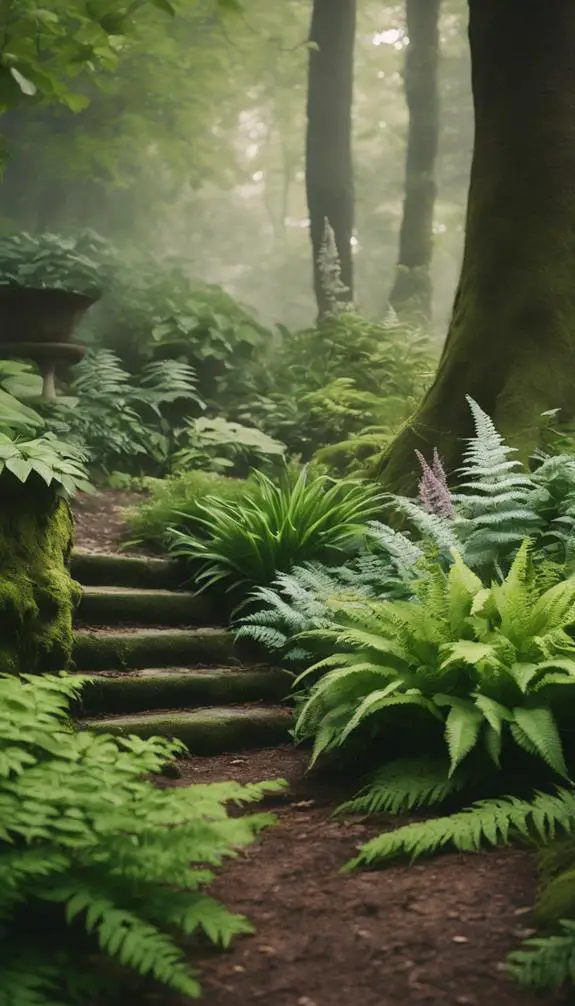
You'll want to plant shade lovers that thrive in low-light conditions, like ferns and hostas, which will add texture and color to your shade garden.
When selecting low-light champions, consider plants with adapted leaf structures, such as variegated or lobed leaves, which allow them to photosynthesize efficiently in shaded areas.
Planting Shade Lovers
Many shade gardens feature a mix of 5-7 shade-loving plants, each chosen for its unique characteristics, growth habits, and blooming periods.
When planting shade lovers, you'll want to ponder a strategic approach. Start by preparing your shade garden bed with organic matter and a balanced fertilizer.
Then, group plants by their light requirements, with the most shade-tolerant plants towards the north or east. Ponder a layered planting strategy, with taller plants towards the north and shorter ones towards the south.
This will guarantee each plant receives the right amount of light. Finally, water thoroughly after planting and mulch to retain moisture.
Selecting Low-Light Champions
As the shade garden bed takes shape, attention turns to selecting the right plants for the job.
You'll want to choose varieties that thrive in low-light conditions, as even shade-tolerant plants can struggle in deep shade. Consider the shade types in your garden: dappled, partial, or full shade.
Dark Leaf plants like coleus and heuchera excel in partial shade, while ferns and hostas thrive in full shade.
Don't overlook shade-loving groundcovers like vinca minor or lamium, which can fill gaps between pavers or stones.
When selecting plants, look for characteristics like variegated or silver foliage, which can reflect light and add visual interest to your shade garden.
Lighting Ideas for Shade Gardens

When designing a shade garden, one crucial aspect often overlooked is lighting, which can greatly impact the ambiance and functionality of the space.
You'll want to incorporate lighting that not only illuminates the area but also creates visual interest. Consider using Solar Lanterns, which harness natural energy to provide soft, warm light.
String Lights, whether hung from trees or woven through shrubs, add a whimsical touch. To create pools of light, place lanterns near seating areas or along pathways.
Creating a Focal Point

Your shade garden's focal point is its visual anchor, drawing the eye to a specific area and creating a sense of harmony within the space.
To create a striking focal point, consider strategic statue placement. A thoughtfully positioned statue can become a beautiful garden anchor, guiding the viewer's gaze and adding depth to the landscape.
When selecting a statue, choose one that complements the surrounding foliage and hardscape. For instance, a modern statue can add a sleek touch to a contemporary shade garden, while a classical piece can enhance a traditional setting.
Mixing Textures and Colors

Three key elements – texture, color, and pattern – come together to create visual interest in a shade garden.
You can create a visually stunning space by combining plants with varying textures, from the soft, delicate foliage of ferns to the rough, rugged bark of mature trees.
Foliage contrasts are essential, as they add depth and visual intrigue. Pair smooth-leaved plants like hostas with plants featuring deeply lobed or serrated leaves, such as heuchera or astilbe.
Bark variations also play a vital role, with trees like birch and beech offering striking white and silver hues that contrast beautifully with the rich greens of surrounding foliage.
Incorporating Hardscapes

You'll add depth and visual interest to your shade garden by incorporating hardscapes that complement your plants.
Rocky garden accents, such as boulders or gravel, can create a striking contrast with lush foliage.
As you design your pathways, consider the material, width, and flow to guarantee a smooth shift between different areas of your garden.
Rocky Garden Accents
Rocky garden accents bring a rugged, natural beauty to shade gardens, and incorporating hardscapes is a great way to add depth and visual interest.
You can create a striking focal point with rock formations, like a large boulder cluster, surrounded by lush greenery. The contrast between the rough, weathered stones and the smooth, delicate leaves creates a visually appealing combination.
Consider incorporating different sizes and shapes of rocks to add texture and dimension to your garden. For example, you can use smaller rocks to create a meandering stream bed or larger rocks to form a naturalistic seating area.
Pathway Design Essentials
A well-designed pathway is crucial in a shade garden, as it guides visitors through the space and creates a sense of flow.
You'll want to ponder the material, width, and layout to guarantee a harmonious experience. Incorporate stepping stones to create a natural, meandering feel, and use curved borders to soften the edges.
This will encourage exploration and invite visitors to linger. When selecting materials, choose those that blend with the surrounding environment, such as natural stone, brick, or gravel.
Avoid abrupt changes in texture or color, as they can disrupt the flow. By thoughtfully designing your pathway, you'll create a cohesive and engaging shade garden that draws visitors in.
Shade Tolerant Flowering Plants

Explore the world of shade tolerant flowering plants, which burst forth with vibrant colors and delicate petals, even in the most shaded areas of your garden.
You'll release Flower Power by incorporating Petal Pushers like impatiens, coleus, and begonias into your design. These shade-tolerant blooms thrive in low-light conditions, adding a pop of color to your garden.
Consider combining them with ferns and hostas for a lush, layered look. With proper care, these flowering plants will flourish, creating a stunning visual display.
Using Ornamental Grasses
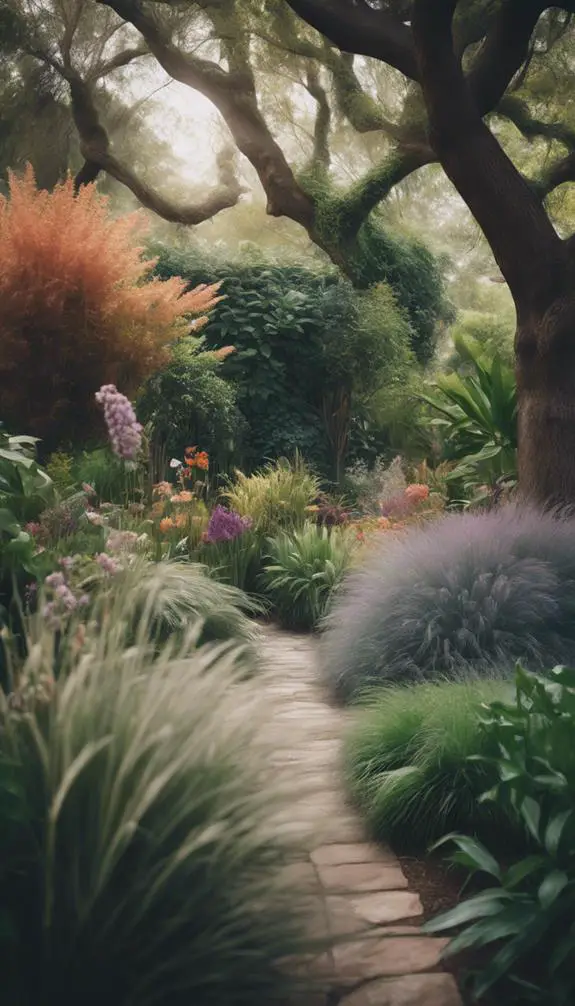
You can add movement and texture to your shade garden by incorporating ornamental grasses, which sway gently in the breeze, creating a soothing visual effect.
These grasses can be used to create beautiful foliage accents, adding depth and visual interest to your garden. Consider using them to create grass borders, defining different areas of your shade garden while adding a touch of elegance.
Ornamental grasses come in a variety of colors, textures, and sizes, allowing you to choose the perfect ones to complement your existing plants. By incorporating them into your garden design, you'll create a dynamic and engaging space that's sure to impress.
Vertical Gardening Options

How can you maximize the potential of your shade garden when space is limited?
By incorporating vertical gardening options, you can tap into new possibilities for your outdoor space.
Consider installing wall planters or living walls, which allow you to cultivate plants on a vertical surface.
This innovative approach not only saves space but also adds visual interest to your garden.
Living walls, in particular, can create a stunning display of foliage, with plants cascading down the wall in a lush, green tapestry.
Water Features for Shade
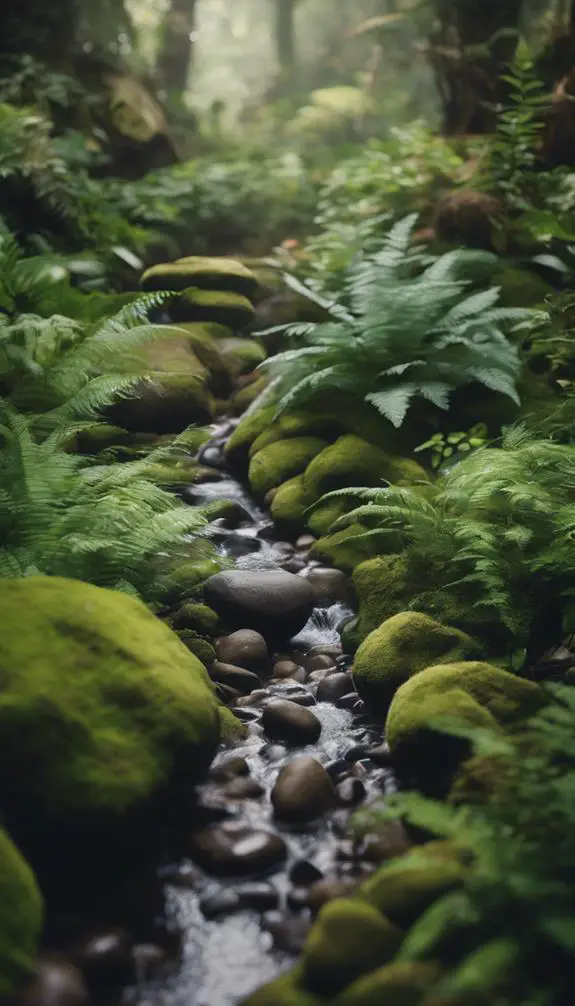
You'll find that incorporating water features into your shade garden can be a masterstroke, as they create a soothing atmosphere that invites relaxation.
Consider serene pond options, where still water reflects the surrounding foliage, or gentle fountain sounds that produce a calming melody.
Alternatively, you might opt for babbling brook effects, which mimic the soft gurgling of a natural stream, adding visual and auditory interest to your shaded oasis.
Serene Pond Options
What could be more calming than the gentle ripples of a serene pond in a shaded corner of your garden?
You'll create a soothing atmosphere by incorporating a pond into your shade garden design. Consider the Pond Edging carefully, as it sets the tone for the entire feature.
You can opt for natural stone, wooden planks, or even recycled materials to create a unique look.
When selecting Water Features, think about the sound and movement you want to achieve.
A small pump can create subtle water circulation, while a larger pump can produce more dramatic effects.
Think about the size and shape of your pond, as well as the surrounding landscape, to choose the perfect Water Features for your serene pond oasis.
Gentle Fountain Sounds
As your serene pond oasis takes shape, the gentle lapping of water against the shore gives way to a new sensory experience: the soothing sounds of a fountain.
Strategically place your fountain to maximize the effect, considering the direction of sound waves. Position it to project sound towards seating areas, creating an immersive experience.
Experiment with different fountain styles, from gentle trickles to more dramatic cascades, to tailor the sound to your desired ambiance.
Babbling Brook Effects
Beyond the soothing sounds of a gentle fountain, a babbling brook effect can transport your shade garden to a serene, natural haven.
You can achieve this by incorporating a small stream or rill that meanders through your garden, creating a sense of movement and visual interest.
To enhance the water sounds, consider adding a few strategically placed rocks or pebbles to create gentle gurgling effects.
As the water flows, it will create a sense of dynamism, drawing your attention to different areas of the garden.
Shade Garden Maintenance Tips

In the dappled shade of your garden, where sunlight filters through the canopy above, regular maintenance is essential to keep your plants thriving.
You'll need to prune shade-tolerant plants regularly to maintain their shape and promote healthy growth. Shade pruning involves cutting back overgrown branches and removing dead or diseased foliage, allowing air and light to circulate.
Schedule seasonal cleanups to remove fallen leaves, twigs, and debris that can harbor pests and diseases. This will also give you a chance to inspect your plants for signs of stress or damage.
Wildlife Friendly Shade Gardens
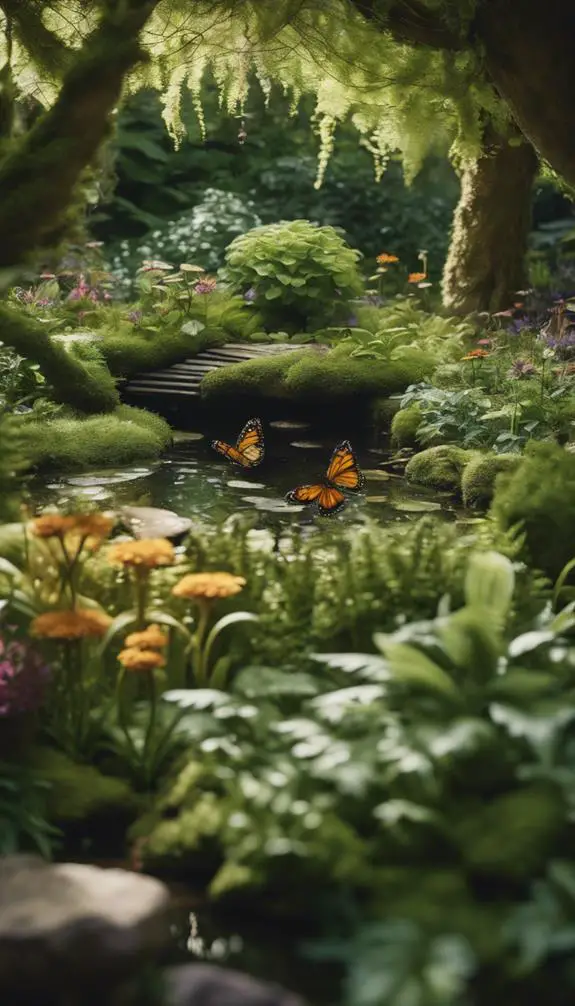
A canopy of native trees above, a tapestry of ferns and wildflowers below – your shade garden is an ideal setting to invite local wildlife to the party.
By incorporating bird attractors like native shrubs and plants with berries, you'll entice feathered friends to visit and stay.
Consider adding insect hotels crafted from natural materials like bamboo, straws, or wood to provide habitats for solitary bees and other beneficial insects.
As you design your wildlife-friendly shade garden, remember to include a water source, like a birdbath or shallow dish, to quench the thirst of your new visitors.
Shade Garden Pathway Ideas

As you meander through your shade garden, a thoughtful pathway design can elevate the entire experience, guiding visitors through the serene atmosphere you've created.
To achieve this, consider moss stepping stones, which blend seamlessly into the forest floor, creating an immersive experience.
By incorporating natural materials like wood chips, pebbles, or decomposed granite, you can create a pathway that echoes the forest floors, blending your garden with the surrounding landscape.
Add some subtle lighting to highlight the pathway's texture and guide visitors through the shaded areas.
The result is a harmonious balance between nature and design, drawing attention to the beauty of your shade garden.
FAQs
Can I Grow Vegetables in a Shade Garden?
You can grow vegetables in shaded areas, but you'll need to choose options with high shade tolerance. Look for varieties like leafy greens, herbs, and brassicas that thrive in low-light conditions, and experiment with vertical gardening to maximize space.
How Do I Control Weeds in a Shaded Area?
To control weeds in a shaded area, you'll want to deploy a multi-layered defense: lay down a weed barrier to block seed germination, then add 2-3 inches of organic mulch layers to suppress growth, ensuring a weed-free haven.
Are Shade Gardens More Prone to Pests and Diseases?
You're more likely to encounter fungal issues and hidden threats in shaded areas, as moisture and humidity create an ideal environment for pests and diseases to thrive, making it vital to monitor your garden closely for early detection.
Do Shade Gardens Require Less Watering Than Sunny Gardens?
You'll find that gardens with partial shade typically require less frequent watering due to retained moisture levels in the soil, especially in organic-rich soil types that absorb and release water slowly, reducing evaporation and runoff.
Can I Use Shade Gardens to Create a Private Outdoor Space?
You can craft a private oasis in your backyard by strategically positioning shade-tolerant plants, trellises, and screens to create a secluded retreat, perfect for relaxation or entertainment, without sacrificing style or functionality.
Conclusion
You've carefully crafted a serene shade garden, balancing design and nature. Now, step back and appreciate the harmony. The chosen plants thrive in the dappled light, while strategic lighting highlights their unique textures and colors. A focal point draws the eye, and water features create a soothing ambiance. With regular maintenance, your shade garden will flourish, becoming a haven for both you and local wildlife. Meander along the thoughtfully designed pathway, and let the tranquility envelop you.



